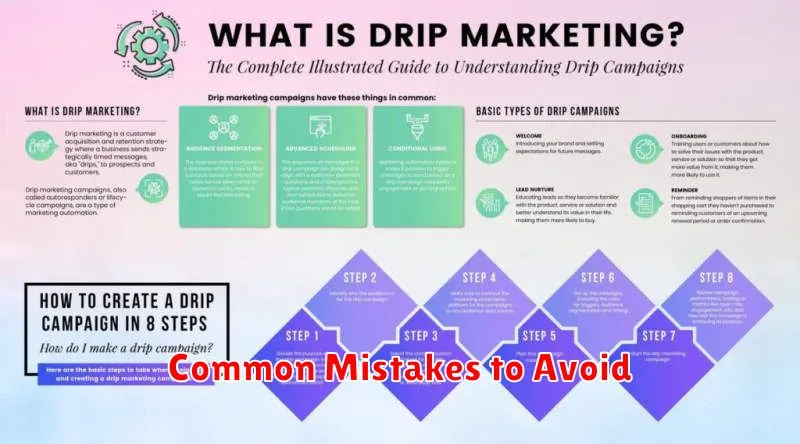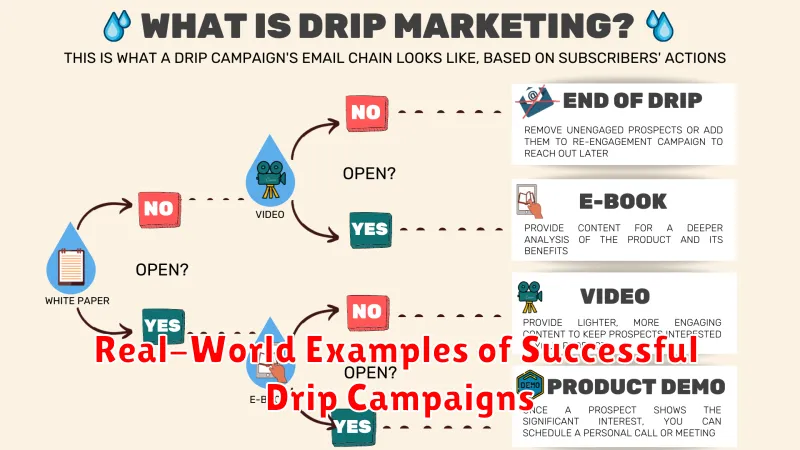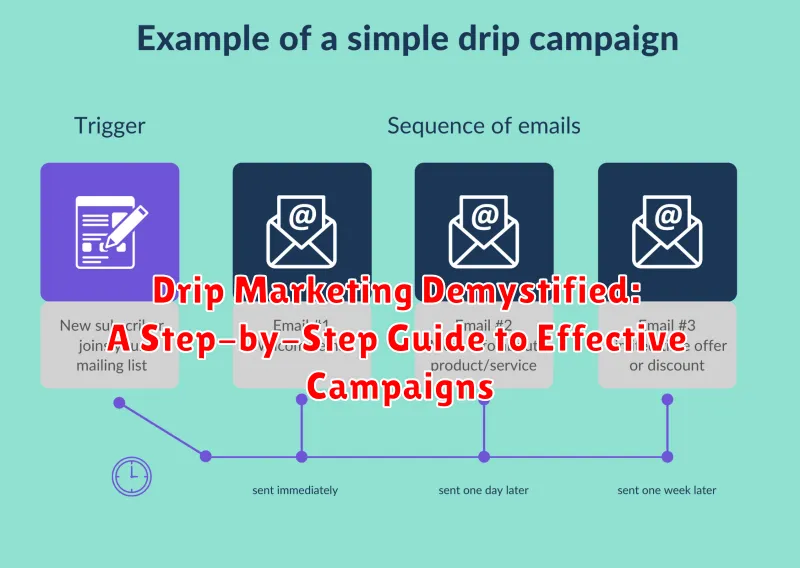Are you looking to nurture leads, build stronger customer relationships, and drive conversions? Drip marketing is a powerful strategy that delivers targeted messages to prospects and customers over time, guiding them through the sales funnel and fostering engagement. This comprehensive guide, “Drip Marketing Demystified: A Step-by-Step Guide to Effective Campaigns,” will provide a clear understanding of what drip marketing is, its benefits, and how to implement it effectively.
Learn how to create effective drip campaigns that resonate with your audience and achieve your marketing goals. From crafting compelling content and segmenting your audience to selecting the right automation tools and analyzing campaign performance, this guide covers everything you need to know to master the art of drip marketing. Discover the power of automated, personalized communication and unlock the potential of drip campaigns to boost your business growth.
What is Drip Marketing?
Drip marketing is a direct marketing strategy that sends, or “drips,” pre-written emails to prospects or customers over a set period. Think of it as a carefully planned sequence of communications, each designed to nurture leads, build relationships, and eventually guide them towards a desired action, like making a purchase.
Unlike a broadcast email blast sent to everyone on your list at once, drip campaigns deliver content strategically. These automated email sequences are triggered by specific actions or timed intervals. For example, a welcome series might begin immediately after someone signs up for your newsletter. Alternatively, an abandoned cart email could be triggered a few hours after a shopper leaves items in their online shopping basket.
These campaigns deliver targeted messages based on subscriber behavior, preferences, or demographics. This personalized approach helps build trust and rapport over time, making your audience more receptive to your marketing efforts.
Why Use Drip Marketing?
Drip marketing offers several key advantages over traditional, one-off marketing blasts. It allows for more targeted and personalized communication, fostering stronger relationships with prospects and customers.
Nurture Leads: Drip campaigns excel at nurturing leads by providing valuable information at each stage of the buyer’s journey. This consistent engagement helps move them through the sales funnel and increases the likelihood of conversion.
Increased Engagement: By delivering relevant content at the right time, drip marketing keeps your audience engaged and reinforces your brand message. This regular interaction helps build trust and top-of-mind awareness.
Improved Conversion Rates: Automated drips ensure consistent follow-up, which is crucial for converting leads into paying customers. By providing timely reminders and addressing specific needs, drip campaigns can significantly improve conversion rates.
Enhanced Customer Retention: Beyond lead nurturing, drip marketing can also be used to onboard new customers, promote upsells, and encourage repeat purchases, ultimately boosting customer lifetime value.
Measurable Results: Drip campaigns are easily trackable, allowing you to monitor key metrics such as open rates, click-through rates, and conversions. This data provides valuable insights into campaign effectiveness and allows for optimization.
Setting Up Your Drip Marketing Campaign
Setting up a successful drip campaign involves a structured approach. First, choose a reliable email marketing platform. The platform should allow for automation, segmentation, and detailed analytics. Consider factors like ease of use, integration with other tools, and pricing.
Next, define your target audience. Understanding your audience’s needs and preferences is crucial for crafting relevant drip emails. Create detailed buyer personas to represent your ideal customers. This will inform your content strategy and segmentation efforts.
Map out your drip campaign workflow. This involves outlining the sequence of emails and the triggers that initiate them. For example, a welcome series might be triggered by a new signup, while a product education series could be triggered by a purchase.
Establish clear goals for your campaign. What do you want to achieve? Increased engagement? Higher conversion rates? Defining measurable goals will help you track progress and optimize your campaign over time.
Creating Effective Drip Email Content
Crafting compelling drip email content is crucial for campaign success. Each email should provide value to the recipient and move them further down the sales funnel.
Start with a clear subject line that grabs attention and accurately reflects the email’s content. Avoid clickbait tactics; focus on clarity and relevance.
Personalization is key. Address the recipient by name and tailor the message to their specific needs and interests. Referencing past interactions or purchase history can significantly enhance engagement.
Keep the email copy concise and focused. Use strong calls to action that guide the recipient towards the desired outcome, whether it’s downloading a resource, visiting a webpage, or making a purchase.
Maintain a consistent brand voice and ensure your emails are visually appealing. Use a professional template and ensure your emails are mobile-friendly.
Segmenting Your Audience for Personalized Drips
Segmentation is crucial for effective drip marketing. Generic email blasts often fall flat, while targeted messages resonate with individual needs and preferences, leading to higher engagement and conversions. By dividing your audience into smaller, more homogeneous groups, you can tailor your drip campaigns to deliver the right message to the right person at the right time.
Several factors can be used for segmentation, including:
- Demographics: Age, gender, location, income level, etc.
- Behavior: Website activity, purchase history, email engagement, etc.
- Psychographics: Interests, values, lifestyle, etc.
- Engagement Level: New subscribers, active customers, inactive users, etc.
Utilizing these data points allows you to create highly personalized drips. For example, new subscribers might receive a welcome series, while inactive users could get a re-engagement campaign with special offers. By addressing specific needs and pain points, segmented drips foster stronger connections and drive desired actions.
Measuring Your Drip Campaign Results
Analyzing your drip campaign’s performance is crucial for optimization and achieving your marketing objectives. Tracking key metrics provides valuable insights into what’s working and what needs adjustment.
Key Performance Indicators (KPIs) to monitor include:
- Open Rates: The percentage of recipients who opened your emails. A low open rate may indicate issues with your subject lines or sending times.
- Click-Through Rates (CTR): The percentage of recipients who clicked on a link within your email. This metric reflects the effectiveness of your call to action and email content.
- Conversion Rates: The percentage of recipients who completed a desired action, such as making a purchase or filling out a form. This is arguably the most important metric, reflecting the overall success of your campaign.
- Unsubscribe Rates: The percentage of recipients who opted out of receiving your emails. A high unsubscribe rate can signal problems with your content relevance or sending frequency.
- Return on Investment (ROI): Measuring the revenue generated against the cost of your campaign helps determine its overall profitability.
Regularly reviewing these KPIs will allow you to refine your drip campaigns and achieve better results over time.
Common Mistakes to Avoid

Failing to segment your audience is a critical error. Generic drips often fall flat. Tailoring content to specific segments drastically improves engagement.
Another frequent misstep is over-communicating. Bombarding your audience with too many emails leads to unsubscribes and negative brand perception. Find the right balance and frequency for your target audience.
Ignoring analytics is a surefire way to sabotage your campaign. Track open rates, click-through rates, and conversions. This data informs necessary adjustments and optimizations.
Static content can become stale quickly. Keep your drip campaign fresh and relevant by regularly updating content and offers.
Lastly, forgetting the call to action renders your efforts ineffective. Each email should have a clear and compelling call to action, guiding the recipient towards the desired outcome.
Best Practices for Drip Marketing
Segmentation is paramount. Divide your audience into distinct groups based on demographics, behavior, or engagement levels. This allows for more personalized and relevant messaging.
Craft compelling content that provides value to each segment. Focus on addressing their specific needs and pain points. Keep it concise and easily digestible.
Test and optimize your campaigns regularly. A/B test subject lines, email copy, and call-to-actions to identify what resonates best with your audience. Monitor key metrics like open rates, click-through rates, and conversion rates.
Maintain a consistent brand voice and style across all your drip campaigns. This reinforces brand recognition and builds trust.
Ensure your drip campaigns are mobile-friendly. Many people check their email primarily on their smartphones, so your emails need to be easily readable on smaller screens.
Choosing the Right Drip Marketing Software
Selecting the right drip marketing software is crucial for successful campaign execution. Consider these key factors when evaluating different platforms:
Features and Functionality
Ensure the software offers the essential features you need, such as email marketing automation, lead nurturing workflows, segmentation capabilities, and A/B testing. Advanced features like dynamic content personalization and lead scoring can further enhance your campaigns.
Ease of Use
The platform should be intuitive and user-friendly, allowing you to easily create and manage your drip campaigns without requiring extensive technical expertise.
Integrations
Seamless integration with your existing CRM, marketing automation, and analytics tools is essential for streamlining your workflow and gaining valuable insights.
Pricing
Evaluate the pricing structure and ensure it aligns with your budget and business needs. Consider factors like the number of contacts, email sends, and available features.
Real-World Examples of Successful Drip Campaigns

Examining real-world examples can illuminate the practical application and potential impact of effective drip campaigns. Here are a few instances across different industries:
E-commerce: Abandoned Cart Recovery
An online retailer uses a drip campaign to re-engage customers who abandon their shopping carts. The sequence starts with a reminder email a few hours after abandonment, followed by a discount offer if the cart remains untouched. This targeted approach recovers potentially lost sales and reinforces customer engagement.
SaaS: Onboarding New Users
A software company implements a drip campaign to guide new users through their platform. The sequence includes welcome emails, tutorials, feature highlights, and personalized recommendations, fostering user engagement and increasing product adoption.
Non-Profit: Donation Cultivation
A non-profit organization utilizes a drip campaign to cultivate relationships with potential donors. The sequence shares impact stories, highlights the organization’s mission, and invites donors to contribute, strengthening connections and driving donations.

